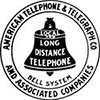Early Telephone ~ Index
Early public telephone utilities in Cache Valley, Rocky Mountain Bell Telephone Company takes over.

Messrs. L.S. Hill and Sharps had a franchise for Salt Lake City and opened a central office and exchange in the Deseret National Bank Building with Mary Ferguson as manager and chief operator. Mr. Patterson, manager of the Western Union Telegraph Company had the franchise for Ogden and Logan and about 1882 or 1883, he decided to establish an exchange at Logan and place Frank Rudd in charge of the construction. The poles were purchased from the Logan Temple, having been used for scaffolding in the construction of the temple. The first central office and switchboard installed was over James T. Hammond's bookstore on Main Street, immediately north of the Pioneer Drug Store. The first operator was Mrs. A. Edwards.
Single wires were used and consequently the lines were noisy and there was a great deal of "Cross Talk." The first exchange consisted of about twenty-five stations at the principal places of business, the Utah Northern Depot. and the several implement houses and the drug store, etc. The exchange was unprofitable and could not be maintained and the switchboard was subsequently removed to the store of Ormsby and Riter, where the switchboard was operated for some time. This was in the old building known as the Pioneer Drug Store, now the site of Riter Brothers Drug Company. This arrangement was continued for some time, and afterward a line was built from Ogden to Logan via Brigham City and the Wellsville Canyon route, and the office moved into the upstairs of the then Riter Block and Mrs. Euphemia King was the operator, later the wife of John P. Cardon.

Later on these private franchises were cancelled and taken over by the Rocky Mountain Bell Telephone Company. C.F. Annett as general manager, George Y. Wallace, president and C.W. Lyman, treasurer. During the development of the Rocky Mountain Bell Telephone Company, they took over many old telegraph lines that would be owned by the Deseret Telegraph Company. The contract for the construction of the first line from Ogden to Logan was given to the late James Mortimer of Logan. The line consisted of twenty-two foot poles, single copper wire, grounded. This was a great innovation when it reached Logan and Mr. Benjamin F. Riter, manager was the first to use the line between Ogden and Salt Lake City. Mr. Riter continued manager for a number of years and resigned when the office was moved from the Riter Block to the present telephone building.
A few years after the exchange was established at Logan, a toll line was built from Logan to Franklin. It was the extreme north station for a number of years. It was afterward extended from Franklin to Preston, where the toll station was established in the Riter Brothers Drug Store and after a time the Preston exchange central office moved into the Riter Block upstairs, where it has remained ever since. Mr. Riter remained with the company after the establishment of these several stations and made the first survey for the line of Logan to Montpelier, Idaho, via Logan Canyon, Right Hand Fork, Meadowville and thence through the several towns to Montpelier. Riter Brothers Drug Company was given the numbers 1 and 2 on the switchboard and the arrangement has been perpetuated to the present day. (1923)

About the time that the line was constructed to Franklin, a branch toll line was built from Logan via Providence, Millville and Hyrum, to Paradise. This was constructed of ordinary fence poles and number-eighteen iron wire was used. After a few years, it was abandoned by reconstruction after the establishment of the Logan Exchange by the Rocky Mountain Bell Telephone Company. The telephone equipment and service of the earlier days was very crude when compared with the present conditions. All of the earlier day instruments have been wholly discarded.
The first telephone instrument installed in the city or valley was placed in the office of George W. Thatcher and connected it with the railroad office. It was considered a great novelty and many came to see how it operated. The railroad company made the installation and it was a private line.